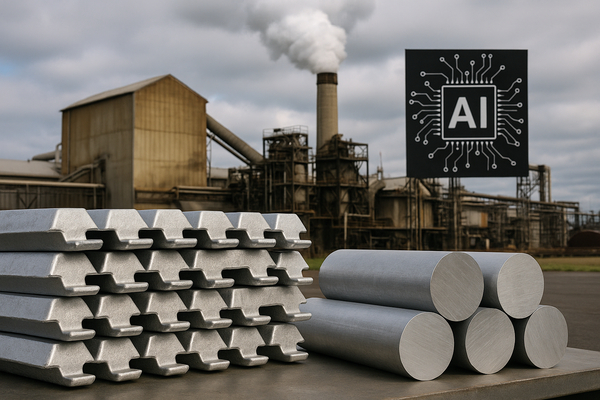
Markets this week pointed to two distinct currents: a raw-materials re-rating driven by changes in physical capacity and a risk-on tilt in tech names supported by capital returns. The most tangible catalyst for the former was Alcoa (AA), whose stock jumped 6.2% after management confirmed the permanent closure of the Kwinana alumina refinery in Western Australia. Management said the decision followed a review of the facility’s age and cost profile; the announcement explicitly reduces Alcoa’s global alumina refining capacity and triggered immediate buying interest that pushed the shares higher by 6.2% on the day.
The Kwinana move reanimated a narrative floated in recent coverage: “Aluminum Could Become the Next Copper.” That thesis is beginning to show up in market prices. Cleveland‑Cliffs (CLF) has seen investor appetite lift the stock by roughly 16% over the last month, a striking one‑month move that echoes renewed optimism for metals exposed to industrial demand. Chart Industries (GTLS) provides another data point: shares closed at $200.25 in the latest session, capping a 60.5% total shareholder return over the past 12 months and an eye‑popping 136.0% gain over five years, underscoring how materials and industrials tied to energy and commodity cycles have become focal points for momentum investors.
Price action in names tied to aluminum and heavy industry is not purely technical. The Alcoa closure reduces refining throughput in Australia, tightening regional supply of alumina feedstock used in primary aluminum smelting; that supply reduction is a concrete, countable event that traders priced into AA, which rose 6.2% on the news. Meanwhile, Cleveland‑Cliffs’ 16% one‑month jump and Chart’s $200.25 close reflect investor willingness to pay higher multiples for companies with leveraged exposure to a potential aluminum re‑rating.
That repricing of cyclicals contrasts with behavior in two other pockets of the market: companies that are using capital allocation to shape narratives, and software names benefitting from AI tailwinds. Elastic (ESTC) is a clear example of the former. At its recent Investor Day the company announced a $500 million share repurchase program and raised revenue guidance for the second quarter and full fiscal year 2026. The market reacted: Elastic shares jumped about 6.7% on the reaction, and multiple research notes cited the $500 million buyback as an unmistakable signal that management is prioritizing EPS accretion alongside product investment.
Capital deployment is also reshaping biotech and clinical‑stage stories. Apogee Therapeutics (APGE) closed a public offering that included the full exercise of the underwriters’ option to purchase additional shares, raising roughly $345 million from the sale of 8,048,782 shares. That financing pushed APGE’s share price higher, with the company’s stock up roughly 38% over the past month as investors bet that expanded R&D funding will accelerate clinical programs and reduce dilution risk over the next year.
Investor psychology in smaller, binary‑outcome names showed up in Arcellx (ACLX), where the stock climbed 7.5% after executives sold shares under prearranged plans and analysts flagged an improving regulatory backdrop for the company’s lead CAR‑T therapy targeting multiple myeloma. The 7.5% intraday move highlights how even insider sales executed through 10b5‑1 plans do not necessarily depress sentiment when analysts and traders see a clearer path to approval; instead, the market focused on the renewed regulatory optimism and priced that expectation into ACLX’s valuation.
Tech momentum has its own mathematics. UiPath (PATH) remains a lightning rod: the automation and AI‑oriented software vendor posted an 18.81% one‑day surge and a 45.18% seven‑day gain in recent sessions after a flurry of product announcements and partnership news. Notably, that rally coincided with a large insider sale — the CEO sold nearly 30 million Class A shares under a prearranged plan — illustrating how significant share dispositions can coexist with momentum flows when buy‑side demand outstrips available liquidity. Those percentage moves — +18.81% and +45.18% — quantify how quickly sentiment can swing when AI narratives accelerate.
At the more conservative end of the spectrum, analyst actions also constrained expectations for some names. Align Technology (ALGN) was downgraded to Hold by Jefferies with a price target cut to $140 from $215, a change that followed survey data showing “modest” incremental penetration of clear aligners through 2030 and continued share loss for Align. The downgrade and the $75 reduction in the price target represent measurable downside in street expectations and help explain why ALGN shares have tumbled roughly 43% over the past year and 62.6% over five years, figures that force investors to weigh valuation against execution risk.
Investor positioning is therefore bifurcated: one cohort is paying up for industrial cyclicals where supply events are quantifiable (Alcoa’s 6.2% pop, Cleveland‑Cliffs’ 16% one‑month move, Chart at $200.25 and 60.5% 1‑year TSR), while another is piling into AI and capital‑return stories (Elastic’s $500 million buyback and 6.7% jump; UiPath’s 18.81% one‑day gain and 45.18% weekly return). Between those poles sit financings that change runway and risk profiles — Apogee’s $345 million raise (8,048,782 shares) being a prime example — and binary biotechs where regulatory optics translate immediately to share‑price shifts (Arcellx +7.5%).
Regional and emerging‑market signals are more measured but still relevant to allocation decisions. Airtel Africa (AARTY) saw its fair value estimate nudged higher: the price target moved from £2.37 to £2.45 per share, a modest uplift that quantifies analysts’ slightly more constructive view on the name even as broader telecom and EM risks persist. On the flip side, industrials such as Arcosa (ACA) have seen short‑term profit taking; ACA’s shares are down 7.4% over the past month despite a three‑year total shareholder return of 56.6%, a numeric reminder that multi‑year winners can still face sharp near‑term reversals.
What investors should take from these cross‑currents is straightforward and measurable: buybacks and capital raises are now explicit balance‑sheet levers shaping near‑term EPS and runway — Elastic’s $500 million program and Apogee’s $345 million raise provide concrete examples — while single‑facility decisions and sector concentration create tangible supply shocks (Alcoa’s Kwinana closure and CLF’s 16% one‑month lift). The market’s reaction has been equally quantifiable: double‑digit percentage swings in PATH, CLF, and GTLS; mid‑single‑digit pops for AA and ESTC; and targeted analyst moves such as ALGN’s $75 cut to the Jefferies price target. Those numbers are the raw data that should guide rebalancing decisions, not catchy headlines.
For allocators, the immediate task is to reconcile valuation with verifiable catalysts: does a 60.5% 12‑month return for Chart at $200.25 reflect sustainable fundamentals, or is it momentum premium? Does a 6.2% one‑day move for Alcoa fully price the impact of permanent capacity removal at Kwinana? And can Elastic’s $500 million buyback translate into the margin and EPS improvements management outlined at Investor Day? The market has begun to put numeric answers beside those questions; the coming weeks will reveal whether price action is durable or simply a re‑rating that reverses as liquidity and sentiment ebb.












